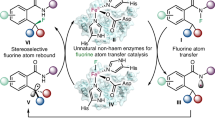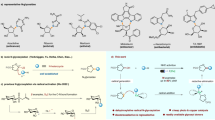Abstract
Cyclooxygenase-2 (COX-2) catalyzes the oxygenation of arachidonic acid and the endocannabinoids 2-arachidonoylglycerol and arachidonoylethanolamide. Evaluation of a series of COX-2 inhibitors revealed that many weak competitive inhibitors of arachidonic acid oxygenation are potent inhibitors of endocannabinoid oxygenation. (R) enantiomers of ibuprofen, naproxen and flurbiprofen, which are considered to be inactive as COX-2 inhibitors, are potent 'substrate-selective inhibitors' of endocannabinoid oxygenation. Crystal structures of the COX-2–(R)-naproxen and COX-2–(R)-flurbiprofen complexes verified this unexpected binding and defined the orientation of the (R) enantiomers relative to (S) enantiomers. (R)-Profens selectively inhibited endocannabinoid oxygenation by lipopolysaccharide-stimulated dorsal root ganglion (DRG) cells. Substrate-selective inhibition provides new tools for investigating the role of COX-2 in endocannabinoid oxygenation and a possible explanation for the ability of (R)-profens to maintain endocannabinoid tone in models of neuropathic pain.
This is a preview of subscription content, access via your institution
Access options
Subscribe to this journal
Receive 12 print issues and online access
$259.00 per year
only $21.58 per issue
Buy this article
- Purchase on Springer Link
- Instant access to full article PDF
Prices may be subject to local taxes which are calculated during checkout






Similar content being viewed by others
References
Di Marzo, V., De Petrocellis, L. & Bisogno, T. The biosynthesis, fate and pharmacological properties of endocannabinoids. Handb. Exp. Pharmacol. 168, 147–185 (2005).
Piomelli, D. The molecular logic of endocannabinoid signalling. Nat. Rev. Neurosci. 4, 873–884 (2003).
Kogan, N.M. & Mechoulam, R. The chemistry of endocannabinoids. J. Endocrinol. Invest. 29, 3–14 (2006).
Ueda, N. et al. Lipoxygenase-catalyzed oxygenation of arachidonylethanolamide, a cannabinoid receptor agonist. Biochim. Biophys. Acta 1254, 127–134 (1995).
Yu, M., Ives, D. & Ramesha, C.S. Synthesis of prostaglandin E2 ethanolamide from anandamide by cyclooxygenase-2. J. Biol. Chem. 272, 21181–21186 (1997).
Kozak, K.R., Rowlinson, S.W. & Marnett, L.J. Oxygenation of the endocannabinoid, 2-arachidonylglycerol, to glyceryl prostaglandins by cyclooxygenase-2. J. Biol. Chem. 275, 33744–33749 (2000).
Snider, N.T., Walker, V.J. & Hollenberg, P.F. Oxidation of the endogenous cannabinoid arachidonoyl ethanolamide by the cytochrome P450 monooxygenases: physiological and pharmacological implications. Pharmacol. Rev. 62, 136–154 (2010).
Chen, J.K. et al. Identification of novel endogenous cytochrome P450 arachidonate metabolites with high affinity for cannabinoid receptors. J. Biol. Chem. 283, 24514–24524 (2008).
Nirodi, C.S., Crews, B.C., Kozak, K.R., Morrow, J.D. & Marnett, L.J. The glyceryl ester of prostaglandin E2 mobilizes calcium and activates signal transduction in RAW264.7 cells. Proc. Natl. Acad. Sci. USA 101, 1840–1845 (2004).
Sang, N., Zhang, J. & Chen, C. PGE2 glycerol ester, a COX-2 oxidative metabolite of 2-arachidonoyl glycerol, modulates inhibitory synaptic transmission in mouse hippocampal neurons. J. Physiol. (Lond.) 572, 735–745 (2006).
Sang, N., Zhang, J. & Chen, C. COX-2 oxidative metabolite of endocannabinoid 2-AG enhances excitatory glutamatergic synaptic transmission and induces neurotoxicity. J. Neurochem. 102, 1966–1977 (2007).
Hu, S.S., Bradshaw, H.B., Chen, J.S., Tan, B. & Walker, J.M. Prostaglandin E2 glycerol ester, an endogenous COX-2 metabolite of 2-arachidonoylglycerol, induces hyperalgesia and modulates NFkappaB activity. Br. J. Pharmacol. 153, 1538–1549 (2008).
Richie-Jannetta, R. et al. Structural determinants for calcium mobilization by prostaglandin E2 and prostaglandin F2α glyceryl esters in RAW 264.7 cells and H1819 cells. Prostaglandins Other Lipid Mediat. 92, 19–24 (2010).
Cravatt, B.F. et al. Molecular characterization of an enzyme that degrades neuromodulatory fatty-acid amides. Nature 384, 83–87 (1996).
Dinh, T.P., Kathuria, S. & Piomelli, D. RNA interference suggests a primary role for monoacylglycerol lipase in the degradation of the endocannabinoid 2-arachidonoylglycerol. Mol. Pharmacol. 66, 1260–1264 (2004).
Piomelli, D., Giuffrida, A., Calignano, A. & Rodriguez de Fonseca, F. The endocannabinoid system as a target for therapeutic drugs. Trends Pharmacol. Sci. 21, 218–224 (2000).
Cravatt, B.F. & Lichtman, A.H. Fatty acid amide hydrolase: an emerging therapeutic target in the endocannabinoid system. Curr. Opin. Chem. Biol. 7, 469–475 (2003).
Long, J.Z. et al. Selective blockade of 2-arachidonoylglycerol hydrolysis produces cannabinoid behavioral effects. Nat. Chem. Biol. 5, 37–44 (2009).
Guay, J., Bateman, K., Gordon, R., Mancini, J. & Riendeau, D. Carrageenan-induced paw edema in rat elicits a predominant prostaglandin E2 (PGE2) response in the central nervous system associated with the induction of microsomal PGE2 synthase-1. J. Biol. Chem. 279, 24866–24872 (2004).
Prusakiewicz, J.J., Duggan, K.C., Rouzer, C.A. & Marnett, L.J. Differential sensitivity and mechanism of inhibition of COX-2 oxygenation of arachidonic acid and 2-arachidonoylglycerol by ibuprofen and mefenamic acid. Biochemistry 48, 7353–7355 (2009).
Rimon, G. et al. Coxibs interfere with the action of aspirin by binding tightly to one monomer of cyclooxygenase-1. Proc. Natl. Acad. Sci. USA 107, 28–33 (2010).
Kulmacz, R.J. & Lands, W.E.M. Stoichiometry and kinetics of the interaction of prostaglandin H synthase with anti inflammatory agents. J. Biol. Chem. 260, 12572–12578 (1985).
Dong, L. et al. Human cyclooxygenase-2 is a sequence homodimer that functions as a conformational heterodimer. J. Biol. Chem. 286, 19035–19046 (2011).
Bhattacharyya, D.K., Lecomte, M., Rieke, C.J., Garavito, R.M. & Smith, W.L. Involvement of arginine 120, glutamate 524, and tyrosine 355 in the binding of arachidonate and 2-phenylpropionic acid inhibitors to the cyclooxygenase active site of ovine prostaglandin endoperoxide H synthase-1. J. Biol. Chem. 271, 2179–2184 (1996).
Duggan, K.C. et al. Molecular basis for cyclooxygenase inhibition by the non-steroidal anti-inflammatory drug, naproxen. J. Biol. Chem. 285, 34950–34959 (2010).
Selinsky, B.S., Gupta, K., Sharkey, C.T. & Loll, P.J. Structural analysis of NSAID binding by prostaglandin H2 synthase: time-dependent and time-independent inhibitors elicit identical enzyme conformations. Biochemistry 40, 5172–5180 (2001).
Kurumbail, R.G. et al. Structural basis for selective inhibition of cyclooxygenase-2 by anti-inflammatory agents. Nature 384, 644–648 (1996).
Lötsch, J., Geisslinger, G., Mohammadian, P., Brune, K. & Kobal, G. Effects of flurbiprofen enantiomers on pain-related chemo-somatosensory evoked potentials in human subjects. Br. J. Clin. Pharmacol. 40, 339–346 (1995).
Bishay, P. et al. R-flurbiprofen reduces neuropathic pain in rodents by restoring endogenous cannabinoids. PLoS ONE 5, e10628 (2010).
Jamali, F., Berry, B.W., Tehrani, M.R. & Russell, A.S. Stereoselective pharmacokinetics of flurbiprofen in humans and rats. J. Pharm. Sci. 77, 666–669 (1988).
Brune, K., Geisslinger, G. & Menzel-Soglowek, S. Pure enantiomers of 2-arylpropionic acids: tools in pain research and improved drugs in rheumatology. J. Clin. Pharmacol. 32, 944–952 (1992).
Uddin, M.J. et al. Selective visualization of cyclooxygenase-2 in inflammation and cancer by targeted fluorescent imaging agents. Cancer Res. 70, 3618–3627 (2010).
Rouzer, C.A. & Marnett, L.J. Glycerylprostaglandin synthesis by resident peritoneal macrophages in response to a zymosan stimulus. J. Biol. Chem. 280, 26690–26700 (2005).
Yang, H. & Chen, C. Cyclooxygenase-2 in synaptic signaling. Curr. Pharm. Des. 14, 1443–1451 (2008).
Woodward, D.F. et al. The pharmacology and therapeutic relevance of endocannabinoid derived cyclo-oxygenase (COX)-2 products. Pharmacol. Ther. 120, 71–80 (2008).
Liang, Y., Woodward, D.F. & Guzman, V.M. Identification and pharmacological characterization of the prostaglandin FP receptor and FP receptor variant complexes. Br. J. Pharmacol. 154, 1079–1093 (2008).
Di Marzo, V. The endocannabinoid system: its general strategy of action, tools for its pharmacological manipulation and potential therapeutic exploitation. Pharmacol. Res. 60, 77–84 (2009).
Blankman, J.L., Simon, G.M. & Cravatt, B.F. A comprehensive profile of brain enzymes that hydrolyze the endocannabinoid 2-arachidonoylglycerol. Chem. Biol. 14, 1347–1356 (2007).
Xie, S. et al. Inactivation of lipid glyceryl ester metabolism in human THP1 monocytes/macrophages by activated organophosphorus insecticides: role of carboxylesterases 1 and 2. Chem. Res. Toxicol. 23, 1890–1904 (2010).
Glaser, S.T. & Kaczocha, M. Cyclooxygenase-2 mediates anandamide metabolism in the mouse brain. J. Pharmacol. Exp. Ther. 335, 380–388 (2010).
Rowlinson, S.W., Crews, B.C., Lanzo, C.A. & Marnett, L.J. The binding of arachidonic acid in the cyclooxygenase active site of mouse prostaglandin endoperoxide synthase-2 (COX-2): a putative L-shaped binding conformation utilizing the top channel region. J. Biol. Chem. 274, 23305–23310 (1999).
Kalgutkar, A.S., Kozak, K.R., Crews, B.C., Hochgesang, J.G.P. & Marnett, L.J. Covalent modification of cyclooxygenase-2 (COX-2) by 2-(acetoxyphenyl)alkyl sulfides, a new class of selective COX-2 inactivators. J. Med. Chem. 41, 4800–4818 (1998).
Otwinowski, Z. & Minor, W. Processing of X-ray diffraction data collected in oscillation mode. Methods Enzymol. 276A, 307–326 (1997).
Vagin, A. & Teplyakov, A. An approach to multi-copy search in molecular replacement. Acta Crystallogr. D Biol. Crystallogr. 56, 1622–1624 (2000).
Emsley, P. & Cowtan, K. Coot: model-building tools for molecular graphics. Acta Crystallogr. D Biol. Crystallogr. 60, 2126–2132 (2004).
Adams, P.D. et al. PHENIX: building new software for automated crystallographic structure determination. Acta Crystallogr. D Biol. Crystallogr. 58, 1948–1954 (2002).
Wu, H.H. et al. Glial precursors clear sensory neuron corpses during development via Jedi-1, an engulfment receptor. Nat. Neurosci. 12, 1534–1541 (2009).
Kingsley, P.J. & Marnett, L.J. LC-MS-MS analysis of neutral eicosanoids. Methods Enzymol. 433, 91–112 (2007).
Acknowledgements
This work was supported by the A.B. Hancock Jr. Memorial Laboratory for Cancer Research and by research (CA89450, GM15431, NS064278) and training grants (DA022873, DA031572) from the US National Institutes of Health. It is based upon research conducted at the Advanced Photon Source on the Northeastern Collaborative Access Team beamlines, which are supported by award RR-15301 from the National Center for Research Resources at the US National Institutes of Health. Use of the Advanced Photon Source is supported by the US Department of Energy, Office of Basic Energy Sciences, under contract no. DE-AC02-06CH11357. We are grateful to J. Harp for assistance with crystallography; K. Masuda, M. Brown, R. Stevens and B. Cravatt for a sample of FAAH; A. Brash for a sample of 15-lipoxygenase and J. Uddin for a sample of fluorocoxib A.
Author information
Authors and Affiliations
Contributions
J.J.P., K.C.D. and L.J.M. originated the project. K.C.D. performed all in vitro wild-type COX-2 inhibition experiments. D.J.H. performed all in vitro mutant COX-2 inhibition experiments. K.C.D., J.M. and S.B. determined the COX-2–(R)-naproxen crystal structure, and K.C.D. and S.B. determined the (R)-flurbiprofen crystal structure. Primary DRGs were harvested and cultured by J.L.S. and D.J.H. in the laboratory of B.D.C. D.J.H. designed and executed COX-2 inhibition experiments in DRGs as well as the imaging studies. D.J.H. and J.L.S. performed western blot analysis of DRGs. J.A.O. reviewed the data and offered critical commentary, and L.J.M. oversaw the research and wrote the manuscript, which was reviewed and edited by all authors.
Corresponding author
Ethics declarations
Competing interests
The authors declare no competing financial interests.
Supplementary information
Supplementary Text and Figures
Supplementary Methods and Supplementary Results (PDF 3481 kb)
Rights and permissions
About this article
Cite this article
Duggan, K., Hermanson, D., Musee, J. et al. (R)-Profens are substrate-selective inhibitors of endocannabinoid oxygenation by COX-2. Nat Chem Biol 7, 803–809 (2011). https://doi.org/10.1038/nchembio.663
Received:
Accepted:
Published:
Issue Date:
DOI: https://doi.org/10.1038/nchembio.663
This article is cited by
-
Phytochemical profile, comparative evaluation of Satureja montana alcoholic extract for antioxidants, anti-inflammatory and molecular docking studies
BMC Complementary Medicine and Therapies (2023)
-
Assessment of NSAIDs as potential inhibitors of the fatty acid amide hydrolase I (FAAH-1) using three different primary fatty acid amide substrates in vitro
BMC Pharmacology and Toxicology (2022)
-
Fungicidal amphotericin B sponges are assemblies of staggered asymmetric homodimers encasing large void volumes
Nature Structural & Molecular Biology (2021)
-
Limitations of drug concentrations used in cell culture studies for understanding clinical responses of NSAIDs
Inflammopharmacology (2021)
-
Substrate-selective inhibitors that reprogram the activity of insulin-degrading enzyme
Nature Chemical Biology (2019)



